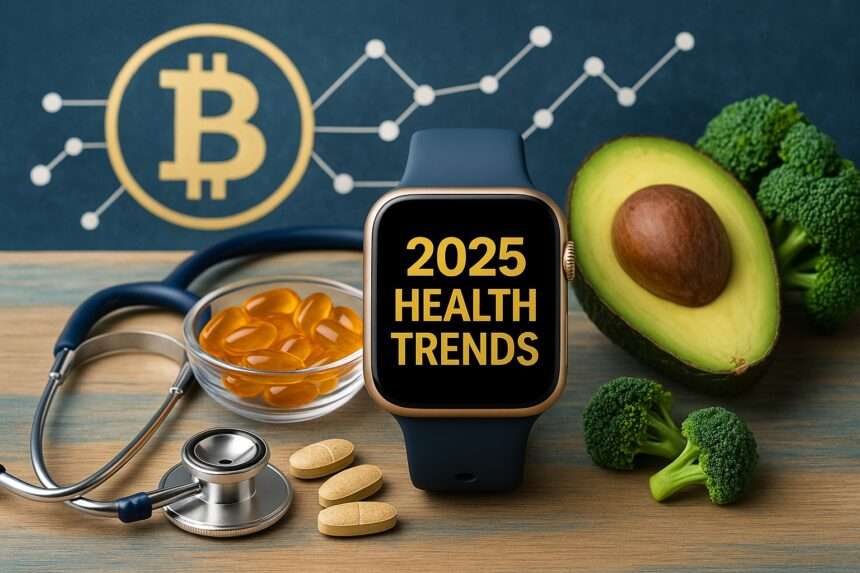Health trends are more than headlines—they change how you book visits, track numbers at home, and get answers between appointments. This guide turns buzzwords into practical steps you can actually use.

Quick facts
- The WHO’s digital health strategy guides countries as telehealth and remote monitoring scale safely.
- OECD reporting shows telemedicine moving from stopgap to core service in many systems.
- In the EU, the AI Act treats many healthcare AI tools as “high-risk,” shaping deployment and oversight.
- The FDA maintains public resources on AI/ML-enabled medical devices to support transparent adoption.
1) Care comes home: monitoring and follow-ups where you live
Home blood pressure cuffs, connected scales, pulse oximeters, and wearables bring clinical context into everyday life. You get earlier warnings, fewer trips, and clearer trendlines. Workflow matters: use the same arm and time, sit five minutes before readings, and share weekly summaries rather than raw streams. The payoff is fewer surprises and faster course-corrections with your clinician.

Make this shift work for you: pick one metric (blood pressure or weight) and track for four weeks. Use a validated device, keep cuffs sized correctly, and send a one-paragraph summary before visits so your clinician can act on patterns, not guesswork. This pattern sits right alongside today’s health trends in remote care.
2) Telemedicine becomes routine—and more effective
Hybrid care is here to stay: secure messages for quick questions, video for visual exams, and in-person for procedures or complex assessments. Prepare a short agenda, test your camera once, and have meds/devices on hand. Among the most durable health trends is using each mode for what it does best—fast answers online, thorough exams in clinic.
3) AI in care: help, not hype
AI supports triage, imaging reads, documentation, and drug-interaction checks. Safe deployment means quality data, transparent labeling, and human oversight. Expect it to reduce admin time and surface risks earlier while clinicians remain accountable for decisions. Responsible use is what separates real progress from noise in discussions about health trends.
4) Prevention gets personal
Wearables, sleep scores, and simple strength plans turn prevention from lectures into routines. The most sustainable approaches emphasize small, repeatable wins: 7,000–8,000 steps most days, two strength sessions weekly, a consistent sleep window, and more fiber on the plate. These basics quietly power many health trends you read about in lifestyle sections—without the fads.
5) Real-world data and interoperability
Shared records, pharmacy data, and device streams help avoid duplicate tests and medication errors. Download your records, keep an up-to-date medication list, and bring it to appointments. When possible, connect your portal to your wearable account so your team sees summaries instead of screenshots—a practical thread that’s woven through modern health trends.
6) Mental health, blended care
Short, structured therapy modules via app or video, paired with periodic in-person sessions, make care more accessible. Start via your primary-care portal, ask for low-waitlist options, and choose services with clear privacy policies and clinician oversight. Blended care fits naturally with broader health trends in access and continuity.
7) Medication access and adherence support
Pharmacy synchronization, automated refills, reminders, and home delivery reduce gaps that lead to complications. Ask your pharmacy about one pickup date for all meds and adherence packaging if you juggle several prescriptions. This is one of those quiet health trends that lowers emergency visits without fanfare.
8) Food-as-medicine and practical nutrition
Medically tailored groceries and “good enough” meal kits help people hit protein and fiber targets without chasing superfoods. Build meals around a protein and two plants, use spices or salsa for flavor, and lean on minimally processed convenience foods. When you do buy packaged items, choose lower sodium and less added sugar, then pair them with vegetables.
9) Privacy and consent by default
Stronger consent screens, transparent data use, and easy opt-outs are becoming standard. Read the first screen, toggle off sharing you don’t want, and review app privacy quarterly. When in doubt, keep health data in reputable, interoperable ecosystems tied to your clinician.
10) Price transparency and simpler payments
Clearer estimates before procedures, network checks, and installment options reduce surprise bills. Before non-urgent care, request an estimate, confirm network status, and ask about equally effective alternatives. A few questions up front save big headaches later.
11) Health literacy and plain-language design
Clinics and apps that use plain language, short paragraphs, and clear visuals help you act faster. Patient-friendly design reduces errors and makes remote care safer. If a tool feels confusing, it’s the tool—not you.
How these health trends change your day-to-day
- Fewer surprises: At-home tracking catches patterns early so small tweaks help.
- Faster answers: Messaging + video visits shorten waits for common questions.
- Better decisions: Shared data clarifies medication lists and follow-up plans.
Simple 7-day starter plan
- Day 1: Set up your patient portal; favorite the message link.
- Day 2: Two blood-pressure readings (one minute apart); log the average.
- Day 3: Add one serving of vegetables to lunch and dinner.
- Day 4: Walk 20–30 minutes after your largest meal.
- Day 5: Lights-out and wake time within the same 60-minute window.
- Day 6: Prepare one question and send it via secure message.
- Day 7: Review the week; keep two habits that fit your life.
Common Questions Include:
Are telemedicine visits as good as in-person? For many follow-ups and common conditions, yes—especially when paired with periodic in-person care for exams and procedures.
Will AI replace clinicians? No. The point is safer, faster care with clinicians in charge. Expect clearer explanations and human oversight inside tools.
Do I need lots of devices? Start with one that fits your goals and budget. Consistency beats gadget collecting.
Related reads on Bulktrends
- Immune Health Basics: 12 Evidence-Backed Habits
- Gut Health 101: Improve Digestion & Overall Health
- The Science of Sleep: How to Get Better Rest
- The Impact of Stress on Your Body and Mind
Authoritative sources
- WHO — Global strategy on digital health 2020–2025 (update brief)
- OECD — Leading practices for the future of telemedicine
- European Commission — AI in healthcare (AI Act overview)
- FDA — AI/ML-enabled medical devices (resources & list)
Educational content only, not medical advice. For symptoms or treatment decisions, talk to your clinician.




